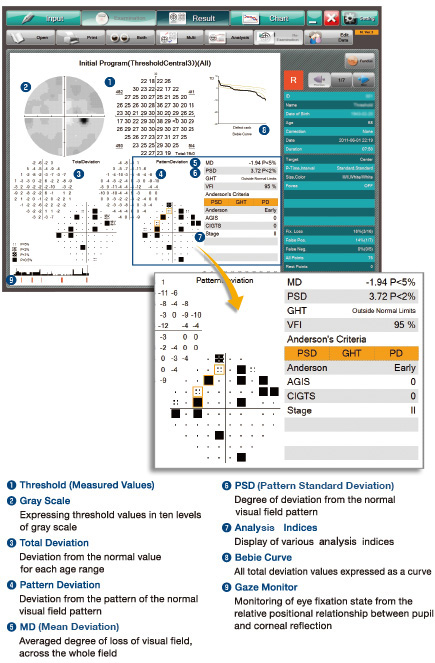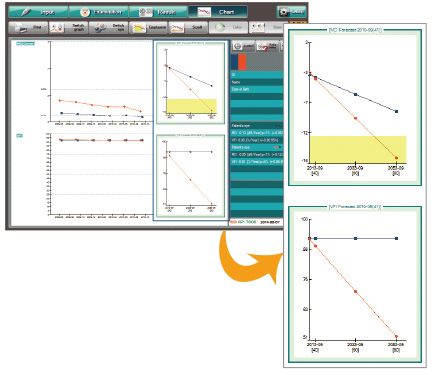Kowa's extensive normative database considers both the central field and the periphery thus ensuring consistent, accurate assessments when using a Kowa AP-7000 perimeter. Full threshold modes offer macular, central, and peripheral coverage up to 80°, while screening modes provide swift evaluation of the visual field. To shorten test times, quick modes are available for both threshold and screening modes. Static perimetry can be linked with fundus images from cameras, OCT, and SLO to define specific test locations on the retina. With its ergonomic, compact design, the AP-7000 offers additional comfort to patients, easy operation for the clinician, and fits perfectly within the practice.
Static perimetry tests can be applied to areas of interest on fundus images taken from a retinal camera, OCT, or SLO.
Threshold test within the central 10°, custom optional threshold test that allows selection of any desired test points, and custom optional screening tests are available.
In addition to central 30° used to observe the progression of glaucoma, other tests are available such as central 10° which can identify visual field abnormalities in the macula.

Predictive graphs are displayed from calculations of linear rates of changes in analysis indices. This function predicts what values of MD and VFI will be reached at what age, if current rates of change in those values continue.
GHT (Glaucoma Hemifield Test)
For this index, threshold central test points are divided into 10 sectors, and corresponding sectors above and below the axis of the horizontal median are compared.
VFI (Visual Field Index)
A percentage index in which a normal visual field is 100% , and total loss of visual field is 0%
Anderson's Criteria Diagnostic Support Function
This criteria is for glaucomatous visual field defect.
If any of the following conditions are satisfied, the colors turn orange.
- PSD has p<5%
- GHT is outside normal limits
- Pattern deviation probability plot shows a cluster of 3 or more nonedge points
that have p<5%, and one of the points has p<1%
(The physician must judge whether the 3 points match the travel of NFL.)
Test result analysis indices can be graphically displayed as time series data to give a clear grasp of changes over time in the tested eyes.

4-zone measurement that goes beyond screening, and programs using probability values (p-values), are among the features that enable effective testing in less time.
Running tests with probability value (p-value) intensities makes it possible to display the difference between the measured value and the normal value for each age range as a p-value, so that the evaluation equivalent to total deviation in thresholds can be performed in a shorter time.
"Automatic measurement function", using many median patterns, "Manual measurement function", allowing free drawing of isopters, and "auto + manual measurement function", which allows any drawing of median after automatic measurement, are among the diverse measurement method options available.
Perform perimetry tests on fundus images
Decibels, deviation maps, probability plots can be integrated with your patients fundus images.
Display with RGC displacement
Photo: Kanazawa University Department of Ophthalmology
(Shinji Ohkubo, M.D. and Kazuhisa Sugiyama, M.D.)
Reference Sjostrand, J., Popovic, Z., Conradi, N., & Marshall, J. (1999). Morphometric Study of the Displacement of Retinal GanglionCells Subserving Cones Within the Human Fovea. Graefe's Archives for Clinical and Experimental Ophthalmology, 237, 1014-1023.
Data from various threshold instruments can be imported. The imported tests ensure that your patients VF history is maintained.
| Dimensions | 730 (W) x 430(D) x 700(H) mm |
| Weight | 26kg |
| Stimulus Presentation Method | Projection |
| Stimulus Color | White, Red, Blue Green |
| Stimulus Size | Goldmann I, II, III, IV, V |
| Maximum Stimulus Intensity | 3,183 cd/m² (10,000 asb): White |
| Stimulus Presentation Time | 0.2 Sec. |
| Stimulus Presentation Interval | 0.6-3.3 Sec. (Automatically Adjusted) |
| Background Intensity | White: 10cd/m² (31.5 asb) Yellow: 100 cd/m² (314.2 asb) (Automatic Light Adjustment) |
| Examination Distance | 300mm |
| Meaurement Range | 80° |
| External Interface | USB, Ethernet |
| Fixation Target | Orange LED Center: 1 Point, Auxiliary: 4 Point Fovea Examination: 4 Point |
| Eye Fixation Monitoring | Heijl Krakau Method, Eye Fixation Monitor, Gaze Monitor |
| Printout | USB-Connected Printer (sold seperately) |
| Operation Screen | Touch Panel Color LCD Monitor |
| Operation Support | Oral Instructions |
| Chin Rest Operation | Motor-driven |
| Screening Program | Standard, Precision, Center, Periphery, Glaucoma, V. Meridian, Center #1, Center #2 |
| Screening Method | 2 Zone, 3 Zone, 4 Zone, Quantity Scotoma Intensity Step: 5dB/Probability Variable (p-value) Quick Mode Available |
| Supra Program | Standard, Macula, Mariotte, Optional, D-Test |
| Supra Method | Same Intensity as 2 Zone |
| Threshold Program | Center 1, Center 2, Meridian, Macula 2, Periphery |
| Threshold Method | All Threshold, Quick 2, Super Quick |
| Isopter Program | Standard, Isopter + Screening 1, Isopter + Screening 2, Isopter + Threshold |
| Isopter Method | Auto, Manual |
| Custom Program | Circle Threshold, 1 Point Threshold, Quadrant Threshold, Optional Threshold#, Optional Threshold◯, Screening#, Screening◯ |
| Perimetry on Fundus | Perimetry Combined Fundus Image |
| Fovea Examination | Available in Threshold Center Examination (Threshold-Center 1, Center 2, Isopter + Threshold) |
| Analysis for Threshold Each Examination | Static Perimetry, Kinetic Perimetry, Blue-on-Yellow, Comparison to Age Related Normative Data, Four Color Stimulus: Red, Blue, Yellow, White, Golmann Size I-V Stimulus |
| Analysis for Threshold Chronological Changes | All Analysis Data: Scale, Threshold, Total Deviation p-value, Pattern Deviation p-value, Bebie Curve Graphically Displays: MD |
| Comparing | Comparison can be made between results of threshold screening or supra examination executed twice |
| Combination | Center, periphery, and isopter examinations can be combined in threshold and screening center examinations. |
| Display Both Eyes | Results of the examination of both eyes of the same patient executed on the same day are displayed side by side |
| Display Multi | Results of the examination executed four times (both eyes/either eye) of the same patient are displayed side by side |
| Database | Patient ID List Display, All List Display, Search Function, ID Extraction Function |
| Patient Information | ID, Name, Date of Birth, Sex, Correction, Visual Acuity, Diagnosis, Doctor, Comments |
| Data Save | Built-in Flash Memory, Capacity: For Approximately 20,000 Patients (40,000 Examinations |
| Normal Eye Database | Ver.1.0.0.0 Issued on 2011/06/09 Age Range: 20s to 70s Samples: 612 persons Criteria: Questioning, Visual Acuity, Reflection |
| Power Supply | Input: AC 100-230V 50/60 Hz Power Consumption: 200VA |
